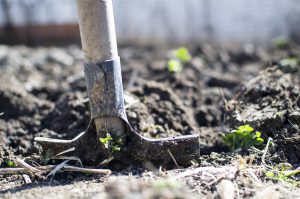Why Proper Bed Preparation Matters
If there’s one thing that can make or break a planting project, it’s the quality of bed preparation. There’s nothing more frustrating than arriving at a site ready to plant, only to find that the soil hasn’t been properly prepared. Instead of getting straight to work, you have to grab a fork and start fixing the beds. The importance of good bed preparation can not be underestimated.
Poorly prepared beds can lead to unhealthy plants, wasted soil, and unnecessary labor. By taking the time to prepare garden beds properly, you not only give plants the best possible start but also ensure long-term success for your landscape

Back breaking but also good exercise!!
Thinking Ahead: The Role of Topsoil
A good gardener knows to plan ahead. When machines have been on-site and the ground has been heavily worked, retaining decent topsoil for reuse later is crucial. Often, what appears to be perfectly smooth soil on the surface can be deceptive—hiding debris, compacted layers, or poor-quality material underneath.
Digging a hole for a shrub or tree can quickly reveal whether corners have been cut. If debris has been buried beneath the surface, it creates challenges for plant establishment and growth. Proper bed preparation means ensuring that the topsoil is of high quality and free from obstructions.
The Necessity of Hand Digging
Even when a bed has been rotavated or machine-dug, it still needs to be worked over by hand. Hand digging ensures that the soil is properly aerated and allows for the removal of large stones, plant material, and other unwanted elements. This step prevents future issues with plant development and allows roots to penetrate the soil more easily.
Choosing the Right Soil: Screened vs. Manufactured Topsoil
If you need to add more soil to the beds, investing in high-quality manufactured topsoil is well worth the cost. Many people opt for screened soil because it meets British Standards, but it often originates from construction sites, meaning it may contain contaminants like small brick fragments or other debris.
While screened soil is suitable for leveling off lawn areas before turfing, it’s not ideal for planting beds. Manufactured topsoil, on the other hand, is blended for optimal plant health and can even be ordered with organic matter or compost mixed in. This provides plants with essential nutrients and improves soil structure.
Enhancing Soil Quality with Organic Matter
If you’re not bringing in new topsoil, enriching the existing soil with organic matter is essential. Organic material such as compost, well-rotted manure, or leaf mold improves soil structure, increases nutrient availability, and enhances moisture retention. This step should always be done by hand to ensure even distribution throughout the bed. Aim to mulch around 10cm deep, this will soon break down so don’t spare
Regularly adding organic matter to garden beds will also encourage beneficial soil organisms, which contribute to healthier, more resilient plants. Learn more about the benefits of organic matter in soil.

Yew pyramid with herbaceous perennials
The Long-Term Benefits of Proper Bed Preparation
Taking the time to prepare planting beds properly isn’t rocket science, but it does make a world of difference. Well-prepared beds give plants the best possible start, allowing them to establish quickly and flourish within just a few months. Personally I will only dig a bed over once, after that I just add good quality compost every to build up a good loam
Investing in good soil preparation from the outset saves time, money, and effort in the long run. The result? A thriving garden that rewards your efforts with lush, healthy growth.
For more gardening tips and expert advice, visit Royal Horticultural Society.

Recent Comments